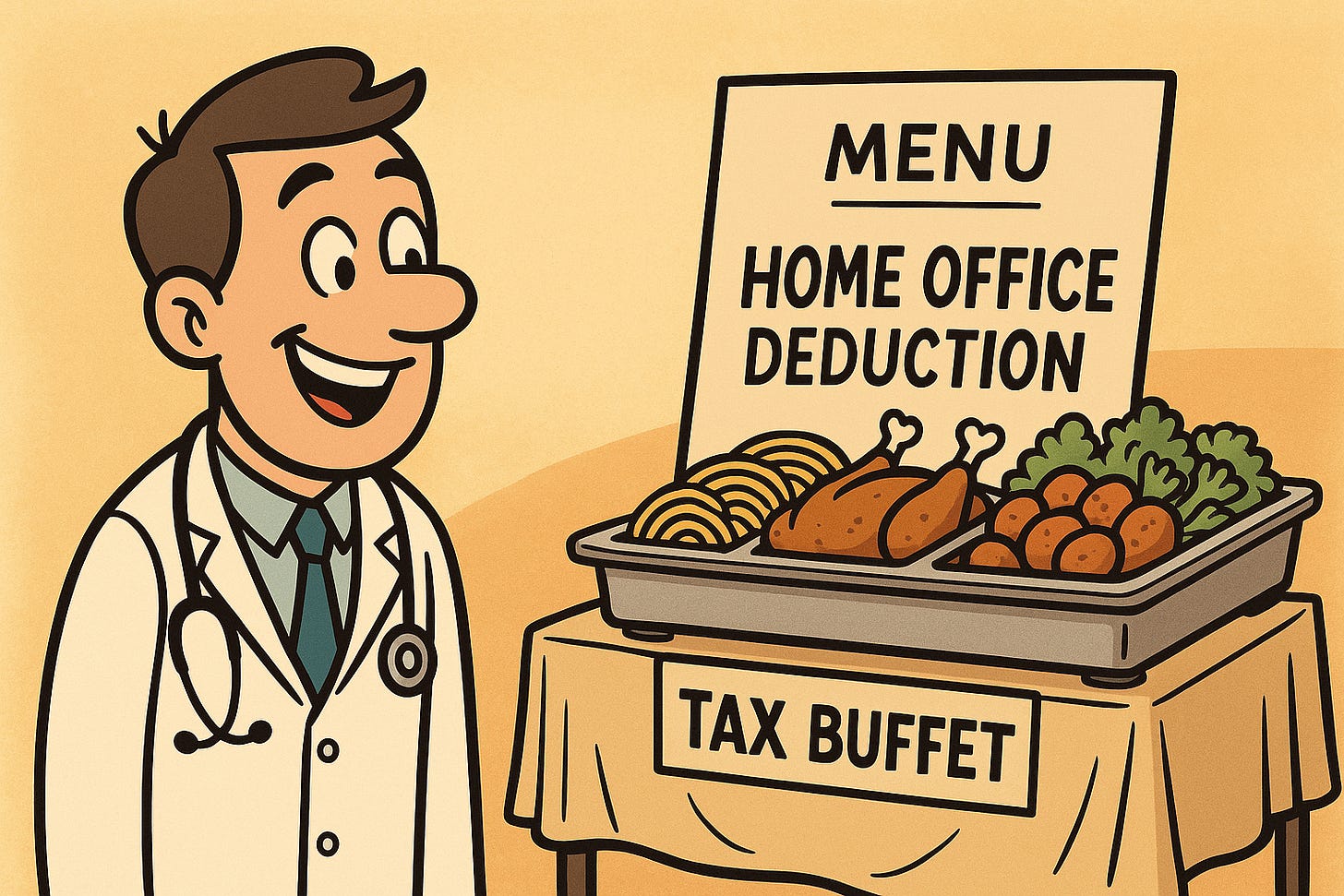Side Gig /= Home Office Deduction
What you need to know before claiming that magical tax break.
For W2 physicians, having side gigs is awesome - it not only lets you tap into your inner entrepreneur without giving up the safety of your W-2 income, but it also opens the door to a buffet of juicy tax deductions.
One of the tasty items on that buffet? The home office deduction!
BUT— here’s the catch: just because you have a side gig doesn’t mean you automatically qualify for it.
The home office deduction is actually a privilege, not a giveaway. You have to earn it by meeting meeting some very specific (and frankly, picky) IRS rules. If you don’t know them, chances are you’re not eligible - and you could be setting yourself up for disappointment or, worse, an audit.
So today, let’s break it down: the two big tests you must pass to claim the home office deduction.
Test 1: Regular and Exclusive Use Test
First up, the space you’re deducting has to be used regularly and exclusively for business.
What do “regularly” and “exclusively” mean?
Well, neither the IRS nor the tax code define them precisely (Ugh!).
That’s left to—you guessed it—”facts and circumstances”. You can think of “facts and circumstances” like a radiologist writing “clinical correlation recommended”. :(
Basically, it depends. The IRS hedges as just must as radiologists (and fairly so). LOL.
Based on court cases, here’s how I interpret these terms in a practical way:
Regularly means roughly 1-2 hours a day, 3–4 times a week.
Exclusively means no personal use - none. That means no Peloton in the corner, no bed for when your spouse kicks you out of the primary bedroom (this has happened to me - true story. LOL). Only include appliances or furnitures used strictly for business - Nothing else.
And please, take a picture of your space. Think of it as audit insurance. You remember Murphy’s Paradox, right? If you prepare for the worst (i.e., audit), the worst won’t happen.
Test 2: The Business Use Test
Your home office also has to pass one of these three conditions:
It’s your principal place of business
It’s a place where you meet patients, clients, or customers
It’s a separate structure (like a backyard office or shed) used exclusively for business
For most physicians, #2 and #3 are a no-go. You’re not inviting patients over for coffee in your home office (so #2 is out), and you probably don’t have a dedicated cottage in the backyard just for your medical work - especially if you live in Manhattan (so #3 is out).
That leaves #1: principal place of business.
How Physicians Can Actually Meet the Principal Place of Business Criteria
Here’s where it gets tricky. There are two ways to meet under the principal place of business criteria:
Relative Importance Test: To pass this test, your home office must be the most important place where you conduct business. For most physicians, this flunks right away - you’re seeing patients at the clinic or hospital, not in your home office.
Administrative or Management Activities Safe Harbor: This is the lifeline for physicians. If you do essentially all your admin or management work (like billing, ordering supplies, scheduling) at home - and you have no other fixed location where you perform these tasks, your home office can qualify as your principal place of business.
And we can all thank Dr. Soliman for this.
A Quick Salute to Dr. Soliman, Anesthesiologist and Accidental Tax Hero.
Dr. Soliman was a self-employed anesthesiologist working at multiple hospitals, clocking about 30-35 hours per week. He had no office space at the hospitals, so he used his home office for 2-3 hours per day handling administrative work. Naturally, he claimed a home office deduction.
The IRS disallowed it, arguing that the “real” business happened at the hospitals, so his home office did not qualify as his principal place of business. But Dr. Soliman didn’t back down—he fought his case all the way up the courts. The Tax Court and the Court of Appeals eventually carved out the administrative safe harbor exception (though he eventually lost at the Supreme Court).
So thanks to Dr. Soliman, Congress later changed the tax law: as long as you do essentially all your admin work at home office—and nowhere else—you can meet the principal place of business test and qualify for the home office deduction.
Bottom Line
You need both:
Pass the Regular and exclusive use Test
Pass the Business Use test - typically by qualifying your home office as your principal place of business through the administrative or management safe harbor. That means doing 100% of your admin or management activities in your home office to pass this test with flying colors.
Only then can you proudly claim the home office deduction.
So before you start writing off that home office, make sure you understand and play by the rules—or risk learning about IRS audits the hard way.
Disclaimer: click here



